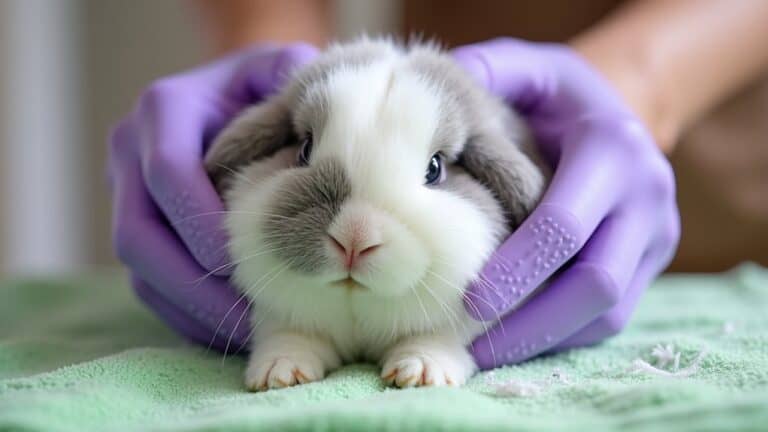Maintaining your bunny's grooming routine might seem like an overwhelming task, especially with their delicate fur and specific needs. However, with a carefully crafted grooming schedule and some expert tips, you can guarantee your bunny's well-being is in top shape.
From shedding to nail trimming and everything in between, this guide will equip you with the knowledge needed to keep your furry friend healthy and content.
So, are you ready to elevate your bunny grooming game and provide your little hopper with the care they deserve?
Contents
- 1 Key Takeaways
- 2 Shedding and Fur Maintenance
- 3 Nail Clipping Techniques
- 4 Ear Care for Bunnies
- 5 Proper Bunny Bathing Methods
- 6 Dental Hygiene for Rabbits
- 7 Eye Health and Care Tips
- 8 Grooming Tools and Supplies
- 9 Creating a Regular Grooming Schedule
- 10 Frequently Asked Questions
- 11 How Does Grooming Schedule and Tips for Bunnies Include Nail Trimming?
- 12 Conclusion
Key Takeaways
- Regular grooming prevents health issues and strengthens the bond.
- Tailor grooming to coat type and shedding seasons for optimal care.
- Professional grooming aids with challenging tasks like matting and knots.
- Consistent grooming routine ensures overall well-being and comfort.
Shedding and Fur Maintenance
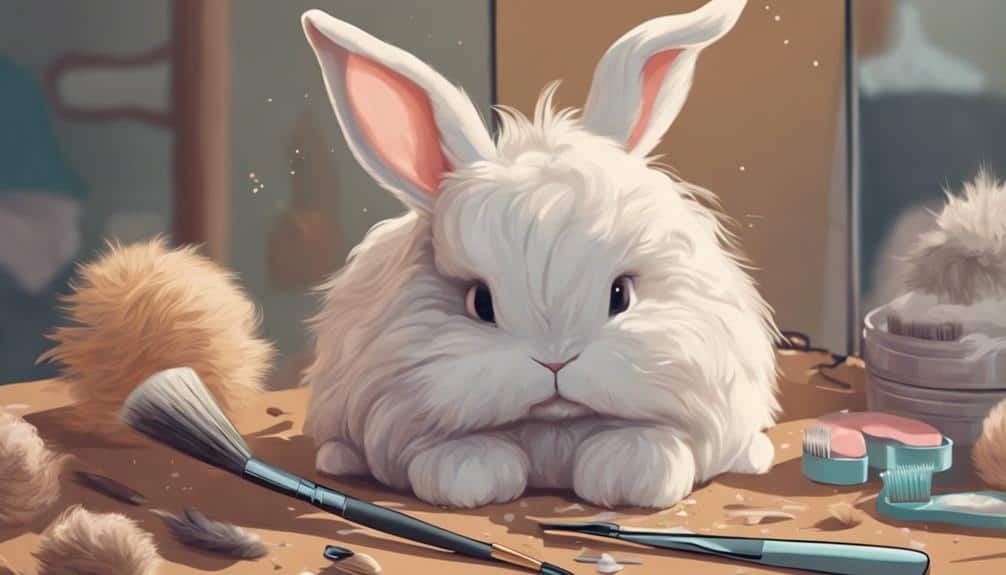
To maintain your bunny's coat health, it's important to understand the shedding patterns and fur maintenance requirements specific to your rabbit's breed and environment. Rabbits typically shed their fur every 3 months, but this can vary based on breed and surroundings.
Long-haired breeds like Lionheads and Angoras need daily grooming to prevent matting, which can lead to discomfort and skin issues. During shedding season, regular brushing is vital to help prevent hairballs and intestinal blockages.
When grooming your rabbit, focus on the undercoat and belly fur, as these areas are prone to matting and tangling. Using grooming tools like fine-toothed combs or flea combs designed for cats can effectively remove loose rabbit hair and keep their coat in top condition.
Nail Clipping Techniques
Understanding the importance of proper nail clipping techniques for your rabbit's regular grooming routine will help maintain their overall health and well-being. Trim your rabbit's nails every 4-6 weeks using guillotine-type nail clippers specifically designed for small animals like rabbits.
Be cautious not to cut the quick, which is the vein inside the nail, to prevent bleeding. In case of accidental quick cuts, have styptic powder on hand to stop any bleeding promptly.
Regular nail trims are essential for your rabbit's foot health, as overgrown nails can lead to discomfort and issues with movement. By incorporating nail clipping into your bunny's grooming schedule, you contribute to their overall well-being and prevent potential complications.
Ear Care for Bunnies
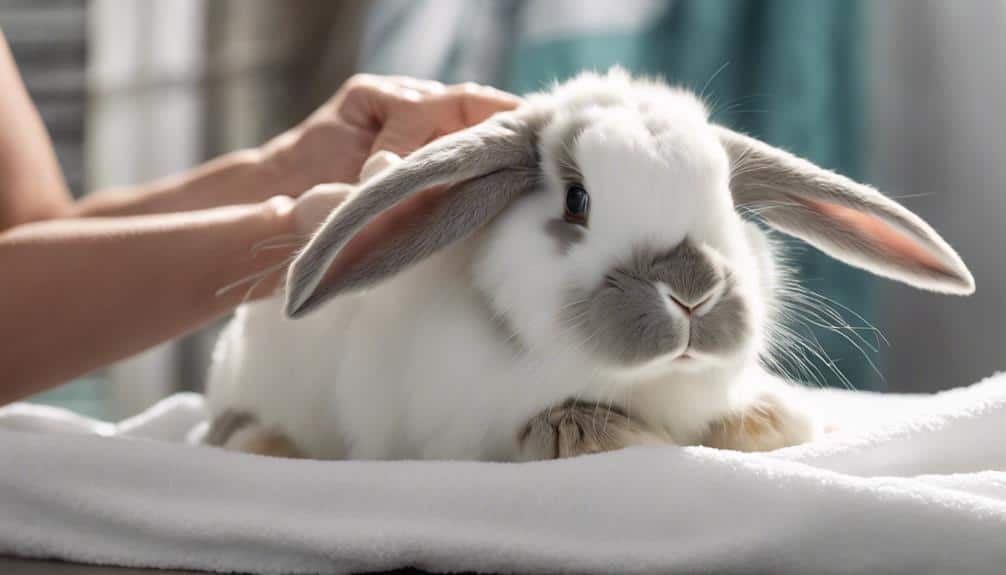
To keep your bunny's ears healthy, regular cleaning is important to prevent infections and wax buildup.
Lop-eared rabbits are especially susceptible to ear issues due to their unique ear shape.
Make sure to consult with a vet for proper ear cleaning techniques to maintain your rabbit's ear health.
Ear Cleaning Basics
When caring for your lop-eared rabbit, it's essential to prioritize regular ear cleanings to prevent wax buildup and potential infections. Lop-eared rabbits are more prone to ear infections due to their unique ear structure. Conduct weekly ear wax checks to maintain your rabbit's ear health.
Before cleaning your rabbit's ears, consult a vet for proper technique and vet-recommended solutions. Use gentle tools like cotton balls for ear cleanings to avoid any harm. Properly cleaning your rabbit's ears helps guarantee wax buildup and reduces the risk of infections.
Preventing Ear Infections
How can you effectively prevent ear infections in your lop-eared bunny through regular and proper ear care?
Lop-eared rabbits are particularly susceptible to ear infections due to their unique ear structure. To maintain your rabbit's ear health, it's important to conduct weekly ear checks to catch any early signs of infection.
When cleaning your bunny's ears, always use vet-recommended solutions and employ gentle techniques to prevent further complications. Before initiating any ear cleanings, consult your vet for guidance on the best practices.
Proper Bunny Bathing Methods
For effective bunny grooming, understanding proper bathing methods is essential to maintain your rabbit's hygiene without causing unnecessary stress. When it comes to bathing your rabbit, here are some key tips to keep in mind:
- Avoid frequent bathing: Rabbits are naturally clean animals and may become stressed by the process.
- Use a damp cloth for spot cleaning: This allows you to target specific areas without causing unnecessary stress.
- Consult a veterinarian for bathing advice: Make sure you're using the right products and techniques for your rabbit's well-being.
- Dry the rabbit thoroughly: After bathing, make sure to dry your rabbit thoroughly to prevent chilling and discomfort, especially in cooler weather.
Dental Hygiene for Rabbits
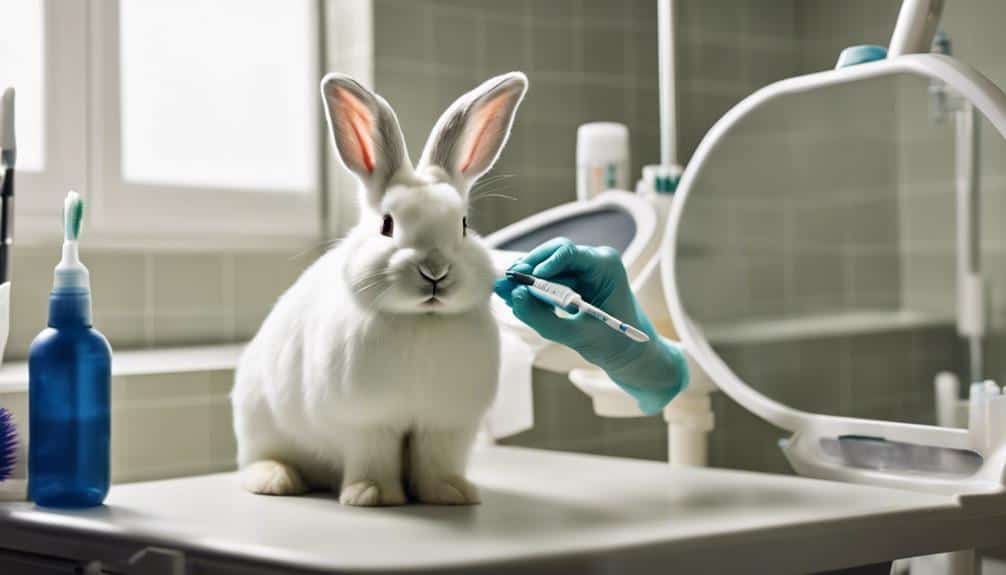
To guarantee your rabbit's overall health and well-being, proper dental hygiene is essential due to the continuous growth of their teeth, which can lead to serious issues if not managed adequately. Rabbit teeth grow constantly, and without regular checks and potential trimming, they can develop malocclusions, causing discomfort, pain, and eating difficulties for your pet.
It's critical to prioritize dental care to maintain proper oral health and prevent overgrown teeth, which can result in serious health concerns and affect your rabbit's ability to eat and groom effectively.
If you notice any signs of dental problems in your rabbit such as drooling, reduced appetite, or changes in behavior, it's important to consult a veterinarian promptly. A professional can assess your rabbit's oral health and perform teeth trimming if necessary to alleviate any discomfort and make sure your rabbit can eat comfortably. Remember, proactive dental care plays a significant role in keeping your rabbit healthy and happy.
Eye Health and Care Tips
Ensuring the best eye health of your rabbit involves regular checks for signs of discharge, redness, or swelling, along with gentle cleaning to prevent infections and discomfort. When caring for your bunny's eyes, here are some essential tips to keep in mind:
- Regular Checks: Inspect your rabbit's eyes frequently for any discharge, redness, or swelling that could indicate an underlying issue.
- Gentle Cleaning: Use a damp cloth or cotton ball to carefully wipe away any crust or debris around the eye area, ensuring your rabbit's eyes stay clean and free from irritants.
- Veterinary Consultation: If you notice persistent eye problems or significant changes in your rabbit's eye health, it's important to seek professional advice from a vet promptly.
- Eye Health Maintenance: Keep the eye area dry and clean to reduce the risk of infections and discomfort for your furry friend. Consider using ophthalmic saline solution to help eliminate excess tears or debris effectively.
Grooming Tools and Supplies
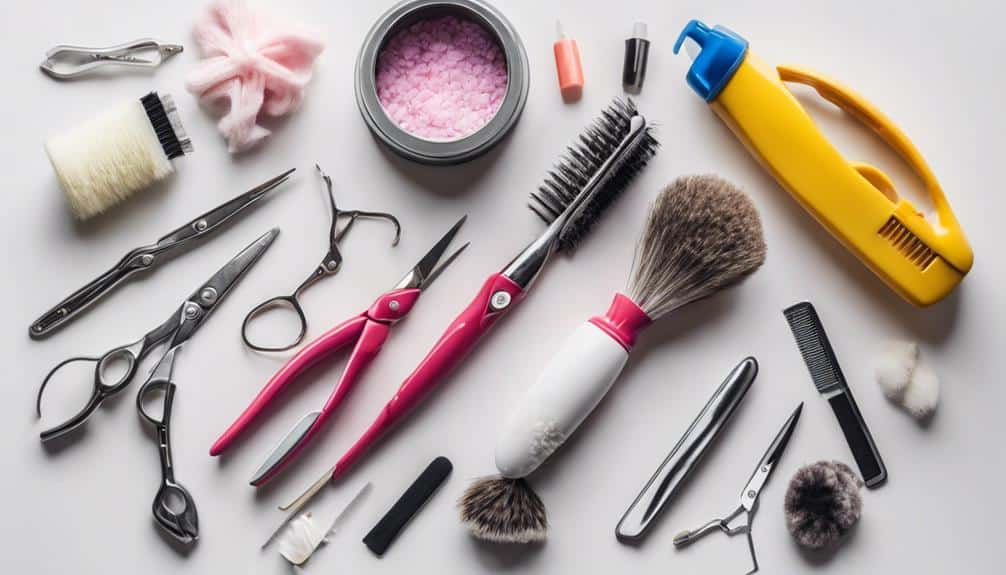
When grooming your rabbit, having the right tools and supplies is essential for maintaining their coat and overall health. Essential tools for rabbit grooming include a fine-toothed comb, flea comb, rubber brush, and mat splitter. The fine-toothed comb helps in detangling and removing loose fur, while the flea comb is effective in removing parasites from your rabbit's coat. Rubber brushes are important for their skin and perfect for surface brushing during grooming sessions. Mat splitters are important for safely detangling mats without causing harm to your bunny's delicate fur.
It's also important to have vet-recommended cleaning solutions, towels, and cotton balls on hand for grooming sessions. These supplies help in keeping your rabbit clean and healthy. Creating a calm grooming space is important for ensuring your bunny feels comfortable and relaxed during the grooming process. With the right tools and supplies, you can effectively groom your rabbit and keep them free from parasites, mats, and other issues that may affect their coat's health.
Creating a Regular Grooming Schedule
Maintaining a regular grooming schedule for your rabbit is key to keeping their coat healthy and ensuring their overall well-being. To create an effective grooming routine for your furry friend, consider the following tips:
- Establish a Weekly Schedule: Setting aside specific times each week for grooming helps in maintaining your rabbit's coat and health.
- Adjust for Shedding Patterns: During shedding seasons, especially for long-haired breeds like Lionheads, daily grooming may be necessary to prevent matting.
- Consider Coat Length: Tailor the grooming frequency based on your rabbit's coat length. Longer coats may require more frequent grooming to prevent tangles.
- Check for Abnormalities: Regular grooming sessions provide an opportunity to inspect your rabbit's skin for any abnormalities or signs of illness.
Frequently Asked Questions
How Often Should You Groom a Bunny?
You should groom a bunny based on its coat type and shedding patterns. During shedding season, daily grooming may be needed. Regular grooming prevents fur matting, hairballs, and skin issues. Use appropriate brush types and tools for efficient grooming.
How Do You Groom a Rabbit Effectively?
When grooming a rabbit effectively, use appropriate grooming tools and proper technique. Dedicate time for bonding and health benefits. Prevent mats, handle stress gently, and consider bathing basics and ear care. Embrace shedding season with patience and care.
What Is Excessive Grooming in Rabbits?
Excessive grooming in rabbits is a concern when they excessively groom themselves, leading to hair loss and skin irritation. Signs include increased grooming frequency, which may indicate stress, boredom, or health issues. Seek veterinary advice for proper management.
What Happens if You Don't Brush Your Rabbit?
If you don't brush your rabbit, you risk hair matting, tangled fur, skin irritations, and grooming difficulties. Neglecting grooming can lead to health risks, behavioral changes, and an uncomfortable bunny. Regular brushing prevents shedding problems and keeps your bunny happy and healthy.
How Does Grooming Schedule and Tips for Bunnies Include Nail Trimming?
When it comes to the best way to trim bunny nails, a regular grooming schedule is essential. Use a dedicated nail trimmer for bunnies and start by getting them used to the process. Make sure to only trim the sharp tip of the nail to avoid cutting the quick.
Conclusion
Now that you have mastered the art of bunny grooming, your furry friend will be as happy as a bunny in a field of clover!
By following this ultimate grooming schedule and tips, you can guarantee your rabbit stays healthy, comfortable, and looking their best.
Remember, a well-groomed bunny is a happy bunny, so keep up with the routine to maintain that strong bond and promote their overall well-being.
Happy grooming!

